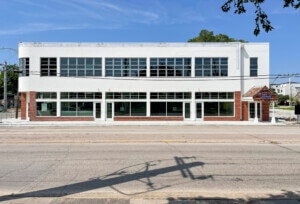The sudden death of Prince last week brought attention to an aspect of the artist that many fans might not have focused on: his history as an architecture patron.
In the mid-1980s, after success from his early albums and his movie Purple Rain, Prince Rogers Nelson began construction on what became a $10 million, 65,000-square-foot compound outside Minneapolis, called Paisley Park Studios. For nearly 30 years, the property at 7801 Audubon Road in suburban Chanhassen, Minnesota, was a safe haven where Prince lived, made music, and entertained. It’s also where he was found unresponsive in an elevator on Thursday and couldn’t be revived.
The main building is as large as big box retail structure, and its white metal panels give it a clean, modern look. Much of it is windowless. A large glass pyramid on the roof above the entrance glowed purple whenever Prince was inside. The interior contains state-of-the-art recording and rehearsal facilities and palatial living areas, with many of the details determined by Prince himself.
Paisley Park was ahead of its time in the way the client wanted to combine areas for work, living and entertainment, according to the project architect, Bret Thoeny of Santa Monica, California-based BOTO Design Architects. “Prince wanted to have a place where he could do all his music and make films and do his tour rehearsals and do dance, choreography and everything under one roof, which back 25 years ago was quite progressive,” said Thoeny in a television interview after the performer’s death.
The design process was a challenge for the architect because Prince couldn’t read blueprints, said Karen Figilis, a spokesperson for BOTO. “Prince requested that architectural models be brought to Minneapolis, so… Bret Thoeny did so,” she said in an e-mail message to The Architect’s Newspaper. “Prince did not want or read blueprints.”
Prince also requested the pyramid for which the building became known, Figilis said. “Prince was very involved in the design.” According to published reports, the complex opened on September 11, 1987, when Prince was 29. He was 57 when he died.
Named after Prince’s 1985 song Paisley Park, and largely credited with putting Minnesota’s music scene on the map nationally, it contains recording studios, a video editing suite, a sound stage, production offices, rehearsal space, private dressing areas and living quarters. Because it had places to sleep, Prince could spend time in the studios whenever he wanted, and he recorded more than two dozen albums there.
The first floor houses the production and performance facilities, and the second level contains executive offices. Thoeny told CNN that Prince wanted no windows downstairs so he could work without knowing whether it was night or day. “A portion of it was like a stay-over where if he was in the studio late, which he always was, he could just crash for a few hours and get back in the studio,” Thoeny said.
Prince kept his many awards locked in a basement vault, along with tapes of unreleased songs. The architect specified the sort of walk-in vault one would find in a bank. “He wanted a place to keep his master recordings, but at the time it was very important to keep this a secret,” he said. According to Time magazine, Prince’s private office has stained glass doors and three beds—king, day and round—with a mirror over the king bed.
Although he guarded his privacy, Prince sometimes opened Paisley Park to visitors for impromptu parties. The last such gathering took place less than a week before he died. “It looks almost exactly like you’d imagine a huge recording complex owned by Prince would look. There is a lot of purple,” The Guardian newspaper reported. “The symbol that represented Prince’s name for most of the 90s is everywhere: hanging from the ceiling, painted on speakers and the studio’s mixing desks, illuminating one room in the form of a neon sign.”
“There is something called the Galaxy Room, apparently intended for meditation: it is illuminated entirely by ultraviolet lights and has paintings of planets on the walls. There are murals depicting the studio’s owner,” the Guardian said. The compound also has been used by others for film work; commercials were filmed there for everything from Burger King to Cadillac to Hormel Chili. Performers who have used Paisley Park Studios for rehearsals include Neil Young, Barry Manilow, Jeff Beck, and the Muppets.










